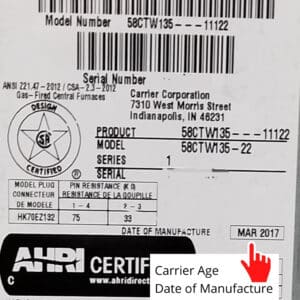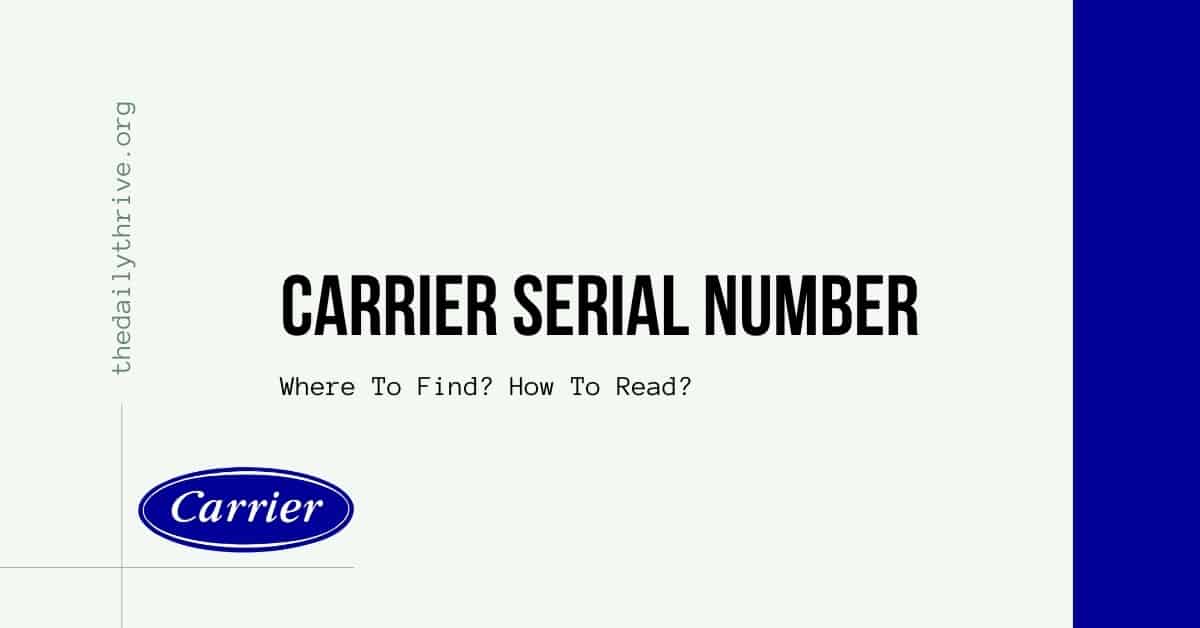When dealing with HVAC systems, particularly those manufactured by Carrier, understanding the serial number is crucial. This article aims to provide a comprehensive guide on Carrier serial number lookup, ensuring you can efficiently utilize this information as a homeowner for maintenance, repairs, and warranty purposes.
A Carrier serial number is more than just a random string of characters. It encodes essential information about the HVAC unit, like the type, model, and date of manufacture. This alphanumeric code is meticulously designed, with each segment revealing specific details about the unit.
Here’s the importance of the Carrier serial number:
- Maintenance and Repairs: Decoding the serial number for model and production details ensures technicians use the correct parts and follow the right maintenance procedures, leading to more effective servicing.
- Warranty registration and/or claims: The serial number’s production date is key for warranty claims, as it reveals the unit’s age, which is crucial for warranty eligibility and safeguarding your investment.
- Upgrades and Replacements: Knowing your unit’s model and age from its serial number is vital for compatibility with new parts and deciding between upgrading or replacing older, less efficient systems for better performance and energy efficiency.
Carrier Serial Number Location
The Carrier serial number is located on the unit’s rating plate. This plate is a label that includes essential information about the equipment, such as manufacturer details, model number, and, most importantly, the serial number.
Here are some common places to find it:
- Air Conditioner and Heat Pump: Look for a data tag on the side or rear of the outdoor unit, typically near the compressor.
- Furnace: Check the inside of the furnace access door or panel. You may also find it on the interior side wall.
The location can vary slightly depending on the model, so consulting the user manual can be helpful.
How to Read Carrier Serial Number
Understanding how the serial number can be decoded is essential to reveal specific details about your HVAC unit. Carrier, as a leading HVAC manufacturer, uses a structured format in their serial numbers, which can be broken down for valuable insights.
- Model and Production Line: The first segment of the Carrier serial number often represents the model number. This is crucial for identifying your unit type, which can range from residential air conditioners to commercial heating systems. Then, it is followed by a code indicating the production line or plant where the unit was manufactured. This can be important for understanding regional manufacturing variations or specific product lines.
- Production Date Information: The next set of characters in the serial number usually indicates the manufacture date. The Carrier often uses a combination of letters and numbers for this. It’s important to note that the format can vary across different models and production years. In some cases, Carrier might use a letter to represent the month and a number for the year.
- Other Manufacturing Details: The serial number may include additional characters that provide further manufacturing details following the production date. These could be internal codes carriers use to indicate specific assembly lines, quality checks, or design variations. This part of the serial number is often more cryptic and may require specific knowledge or resources to decode fully.
Below are the most common styles or formats of Carrier serial numbers:
- #4006A17330
- #0180A12345
- #W4D14008
- #A912345
- #24ACA336
How to Identify the Age of Carrier HVAC from Serial Number
Carrier has utilized different serial number styles, with newer and older units following distinct formats.
New Carrier units, like air conditioners, heat pumps, and furnaces, use a 4-digit code at the beginning of the serial number to denote the age. The first two digits represent the week of manufacture, and the next two indicate the year.
Older Carrier units, however, employed various serial number styles, making it a bit more challenging to deduce the age precisely. These serial numbers might not have a clear-cut format, and decoding them often requires additional resources or reference materials. Sometimes, it might be necessary to consult Carrier customer service or specific Carrier documentation for accurate age determination.
We will demonstrate how to decode each style of Carrier serial number with examples, providing a clear guide to understanding the age of your Carrier HVAC unit, whether it’s a newer model or an older one.
Serial number example:
#0196A12345
We can decode it as follows:
- “01” represents the week of manufacture.
- “96” indicates the year of manufacture.
- “A” is a code for the manufacturing plant.
- “12345” is the sequential number of the unit.
This serial number tells us that the unit was manufactured in the first week of the year 1996.
Serial number example:
#0100V1234
We can decode it as follows:
- “01” represents the week of manufacture.
- “00” indicates the year of manufacture.
- “V” is a code for the manufacturing plant.
- “1234” is the sequential number of the unit.
Therefore, according to this serial number, the unit was manufactured in the first week of the year 2000.
* week: 01 = first week of January, 52 = last week of December
* year: 00 = 2000, 01 = 2001, and so forth.The above examples showcase the new serial number format employed by Carrier.
We will now delve into examples of serial numbers from older Carrier models. These examples will illustrate the unique and varied formats characteristic of Carrier’s earlier HVAC systems, offering a glimpse into the historical approach of Carrier’s product identification and manufacturing timeline. These samples will guide understanding and decoding the age and production details of older Carrier units, showcasing the evolution of their serial number coding over the years.
Serial number example:
#1012345
We can decode it as follows:
- “1” represents the year of manufacture.
- “012345” is the sequential number of the unit.
This serial number is used in units manufactured before 1970.
1 = 1961, 2 = 1962, and so forth.
Serial number example:
#760198765
We can decode it as follows:
- “76” represents the year of manufacture.
- “01” represents the week of manufacture.
- “98765” is the sequential number of the unit.
This serial number is used in units manufactured from 1970-1980.
Serial number example:
#4A012
We can decode it as follows:
- “4” represents the year of manufacture.
- “A” represents the month of manufacture.
- “012” is the sequential number of the unit.
This serial number is used in units manufactured from 1960-1980.
Year: 4 = 1974, 5 = 1975, and so forth. 4 = 1984, 5 = 1985, and so forth.
Month: A through M (omit I), A = January, B = February, and so forth. N through Z (omit O), N = January, P = February, and so forth.
Other example styles used in this decade:
- #312345 = 1st quarter of 1973
- #A598765B = January 1975 (A for January, 5 for 1975)
- #A6A00001 = January 1976
- #N6A00002 = January 1986
- #16V123456 = 16 for week, V for year (V = 1968, W = 1969, X = 1970, Y = 1971, A = 1972, B = 1973, C = 1974, D = 1975, E = 1976)
New Carrier HVAC units also show the year of manufacture directly on the data tag (as shown in the image below). So you don’t have to bother to decode the serial number nomenclature anymore.

Conclusion
Carrier, a well-known manufacturer of air conditioners, heat pumps, and furnaces, is part of a larger corporate family. Carrier’s parent company is Carrier Global Corporation. This corporation oversees several subsidiary brands operating in the HVAC and refrigeration industries.
As a standalone entity, it oversees several sister brands with similar manufacturing processes and product lines. These sister brands often include names like Bryant, Payne, Heil, and Day & Night. While maintaining their unique market identities and product specializations, each brand often shares Carrier’s approach to product design, technology, and even serial number formatting.
This shared approach to serial number formatting means that techniques for deciphering the manufacturing date and other details from a Carrier unit’s serial number can often be applied to these sister brands. For HVAC professionals and consumers, this similarity across brands under the Carrier Global Corporation umbrella simplifies maintenance and service processes, as understanding one brand’s system can be easily transferred to another.
Now that you know the Carrier age from the serial number, you must figure out whether to repair or replace your unit. If your HVAC system is nearing the end of its lifespan, we can help you find an experienced HVAC technician (use the free quotes button). They will help you find the right HVAC system for your home’s price range and needs.
Still unable to find or read the Carrier serial number? Just drop your comment below, and we will be happy to help you.






